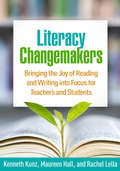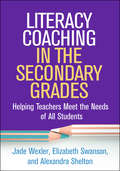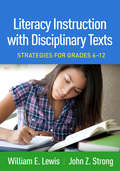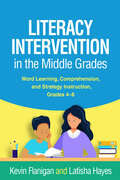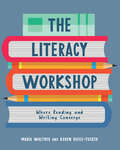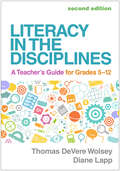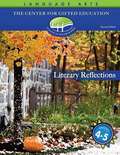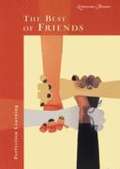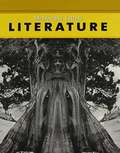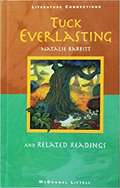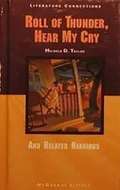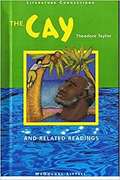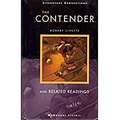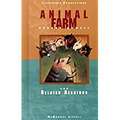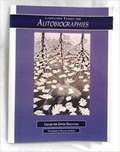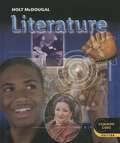- Table View
- List View
Literacy Changemakers: Bringing the Joy of Reading and Writing into Focus for Teachers and Students
by Kenneth Kunz Maureen Hall Rachel LellaThis inspiring book shows how K–12 teachers, literacy specialists and coaches, and school- and district-level administrators can work together to make needed instructional improvements while fostering a lifelong love of reading and writing. The book presents collaborative leadership strategies and research-based best practices for creating joyful, effective learning environments. It includes ways to evaluate and recalibrate literacy programs for sustainable change, provide students with a wide variety of engaging reading opportunities, meet the needs of English learners and adolescent learners, partner with families, and enhance professional learning and development. Teacher-friendly features include practical tips and "Stop, Think, and Take Action" sections in each chapter. Several reproducible forms can be downloaded and printed in a convenient 8 1/2" x 11" size.
Literacy Coaching in the Secondary Grades: Helping Teachers Meet the Needs of All Students (The Guilford Series on Intensive Instruction)
by Elizabeth Swanson Jade Wexler Alexandra SheltonToo many adolescent learners still struggle with reading. This much-needed guide shows how to support teachers in providing effective literacy instruction in the content areas, which can be intensified as needed within a multi-tiered framework. Adaptive Intervention Model (AIM) Coaching was created for grades 6–8, but is equally applicable in high school. The book gives instructional coaches an accessible blueprint for evaluating, developing, and reinforcing each teacher's capacity to implement evidence-based literacy practices. User-friendly features include case studies, end-of-chapter reflection questions and key terms, and reproducible tools. Purchasers get access to a companion website where they can download and print the reproducible materials--plus supplemental lesson plans and other resources--in a convenient 8 1/2" x 11" size.
Literacy Instruction with Disciplinary Texts: Strategies for Grades 6-12
by William E. Lewis John Z. StrongTo develop strong disciplinary literacy skills, middle and high school students need to engage with diverse types of challenging texts in every content area. This book provides a blueprint for constructing literacy-rich instructional units in English language arts, science, and social studies. The authors describe how to design interconnected text sets and plan lessons that support learning and engagement before, during, and after reading. Presented are ways to build academic vocabulary and background knowledge, teach research-based comprehension strategies, and guide effective discussions and text-based writing activities. Chapters also cover how to teach students to write argumentative, informative, and narrative essays, and to conduct discipline-specific inquiry. Special features include sample text sets and 24 reproducible planning templates and other teaching tools; purchasers get access to a Web page where they can download and print the reproducible materials in a convenient 8 1/2" x 11" size.
Literacy Intervention in the Middle Grades: Word Learning, Comprehension, and Strategy Instruction, Grades 4-8
by Dr. Kevin Flanigan Dr. Latisha HayesNo two students in grades 4–8 are identical, and many struggle with literacy for different reasons. Using a teacher-friendly, hands-on approach, this eminently practical book walks educators through the nuts and bolts of literacy intervention in the middle grades. Highlights include &“North Star&” principles to orient instruction, an assessment flowchart, and extended case studies of three middle-grades learners. The book offers evidence-based intervention practices for targeting specific literacy components, including word recognition, fluency, vocabulary, and comprehension. Teachers are guided to plan structured but flexible interventions that promote literacy growth and engagement. Sample lesson plans and clear, engaging figures illustrate how to make literacy intervention work for all students.
Literacy Workshop: Where Reading and Writing Converge
by Maria Walther Karen Biggs-TuckerThe Literacy Workshop: Where Reading and Writing Converge is a first-of-its-kind resource that offers a practical process for creating an integrated literacy workshop using demonstration lessons that align with current curriculum standards. In this forward-thinking book, authors Maria Walther and Karen Biggs-Tucker share what they've learned over countless reading and writing workshops and combine into one literacy workshop. The authors demonstrate how you can save valuable classroom time while still empowering students to uncover exciting connections in their learning – leading to stronger, more motivational readers and writers. By weaving the common threads of literacy learning together, you can increase the time your students spend engaged in authentic reading and writing. Inside you'll find the following: A clear, succinct explanation of the literacy workshop structure, how to get started, and how to determine the best time to begin the merge; 50+ demonstration lesson plans, appropriate for both primary and intermediate grade levels, that use strategies incorporating elements from recommended fiction and nonfiction anchor texts; Substantial, printable resources and online tools to help make this instructional shift as smooth as possible. From the big picture to small, helpful details, The Literacy Workshop will be your guide as you blur the lines between your reading and writing workshops - creating space for students to apply their learning and practice the habits, behaviors, and actions of literate and engaged citizens.
Literacy in the Disciplines: A Teacher's Guide for Grades 5-12
by Diane Lapp Thomas DeVere WolseyThis successful guide--now in a revised and expanded second edition--gives teachers effective strategies to support adolescents' development of relevant literacy skills in specific disciplines. Demonstrating why disciplinary literacies matter, the authors discuss ways to teach close reading of complex texts; discipline-specific argumentation, communication, and writing skills; academic vocabulary; and more. The book draws on revealing interviews with content-area experts and professionals in history, science, mathematics, literature, the arts, and physical education. Teacher-friendly tools include 21 reproducible forms that also can be downloaded and printed, "Try It On!" practice activities, lesson plans, chapter anticipation guides, and links to recommended online teaching videos. New to This Edition *Chapter on assessment. *Chapter on disciplinary literacies beyond school--in civic, professional, and personal life. *Expanded coverage of math, more attention to evidence and sources used in different disciplines, new and updated expert interviews, and advice on how both teachers and students can use AI tools productively. *Anticipation guides that invite reflection on key questions before, during, and after reading most chapters.
Literary Reflections Student Guide Grades 5-6 (Second Edition)
by Mary College of WilliamThe Student Guide contains high-quality literature selections, activity pages, and learning scaffolds designed to enhance writing, reasoning, and analytical skills. <p><p> While integrating all strands of language arts, this unit focuses on interaction with literature while enhancing reading comprehension and textual analysis skills.
Literature & Thought: The Best of Friends
by Perfection LearningThis series contains literature that challenges the reader, promotes critical thinking, and encourages independent exploration of genres, themes and issues.
Literature (Sixth Grade, Michigan Edition)
by Mcdougal LittellAn anthology of Poems, Fiction, non-fiction, drama, etc.
Literature And Language (Gold Level)
by Mcdougal LittelLiterature and Language is different from other books you have used in two important ways. First, it is organized to help you tie together your study of the language arts--literature, writing, and language. The literature, chosen for its appeal to your life, serves as the starting point for all your learning. Students like you helped to select the stories, plays, articles, and poems that appear in this book (see their names on page vi). You'll find stories that have been favorites for many generations, as well as works by current writers.
Literature Connections English: Tuck Everlasting (Mcdougal Littell Literature Connections)
by McDougal-Littell Publishing StaffMcDougal Littell's Literature Connections' Tuck Everlasting and Related Readings
Literature Connections, Roll of Thunder, Hear My Cry and Related Readings
by Mildred D. TaylorNIMAC-sourced textbook
Literature Connections: Animal Farm and Related Readings
by Mcdougal LittellThe contents of the book are: Animal Farm: novel by George Orwell: a powerful fable that uses animals to reflect human political failure; The Stalin Epigram: poem by Osip Mandelstam; The Rebellion of the Magical Rabbits: short story by Ariel Dorfman-A fable about tyranny and rebellion; Crow Song: poem by Margaret Atwood; Harrison Bergeron: short story by Kurt Vonnegut-Total equality--a dream or a nightmare?; The Birds: short story by Daphne du Maurier-Human terror caused by a revolution of birds.
Literature Packet for Autobiographies
by Center for Gifted EducationLiterature Packet for High-ability Learners Grades 5 and 6
Literature Works: A Collection of Readings, Collection 6
by Silver Burdett GinnThis book is designed to teach grade 1-6 students about reading, literature and language arts.
Literature [Grade 6]
by Arthur N. Applebee Jim Burke Douglas Carnine Yvette Jackson Judith A. Langer Robert J. Marzano Mary Lou Mccloskey Donna M. Ogle Carol Booth Olson Lydia Stack Carol Ann Tomlinson Robert T. Jiménez Janet Allen et al.NIMAC-sourced textbook
Literature and the Language Arts: Discovering Literature (2nd Edition)
by EMC CorporationWhen you open your EMC Masterpiece Series textbook, you will find great literature, both classic and contemporary, by a wide variety of authors. You will also find useful step-by-step study strategies for each selection, helpful background information, and activities that allow you to relate the literature to your own experiences and share your point of view.
Literature, Course 1
by Jeffrey D. Wilhelm Douglas Fisher Kathleen A. Hinchman David G. O'Brien Taffy Raphael Cynthia Hynd ShanahanNIMAC-sourced textbook
Literature, Grade 6, Common Core Edition (Holt Mcdougal Literature Ser.)
by Jim Burke Douglas Carnine Yvette Jackson Carol Jago Janet Allen Arthur ApplebeeHOLT McDOUGAL Literature Grade 6 A language arts textbook.
Literature: Timeless Voices, Timeless Themes (Copper Level)
by Richard Lederer Sharon Sorensen Heidi Hayes JacobsLiterature textbook.
Literature: Timeless Voices, Timeless Themes (Copper Level)
by Prentice HallEach form of literature, called a genre, has its own characteristics. In this introduction, you can learn about the genres of literature. Prose is organized in sentences and paragraphs and does not have a regular rhythm. Fiction is prose writing that tells about imaginary characters and events. Nonfiction is prose writing that presents and explains ideas or that tells about real people, places, or events. * Poetry, whose sentences appear in lines that do not always extend across the page, often has a regular beat or rhythm. A short story is a brief form of prose fiction with characters, a setting, and a plot. It resembles longer forms of fiction in exploring an insight into life. Nonfiction is literature that deals with the real world. It tells the story of actual events or people and addresses the world of ideas. Poetry is literature written in verse. Because the form uses comparatively few words, poets choose highly concise and emotionally packed language to convey their ideas. In addition, poetry includes rhythm and rhyme to make the writing musical. Drama tells a story through the words and actions of actors who impersonate the characters on stage. In the text of a drama, the characters' words are called the dialogue.
